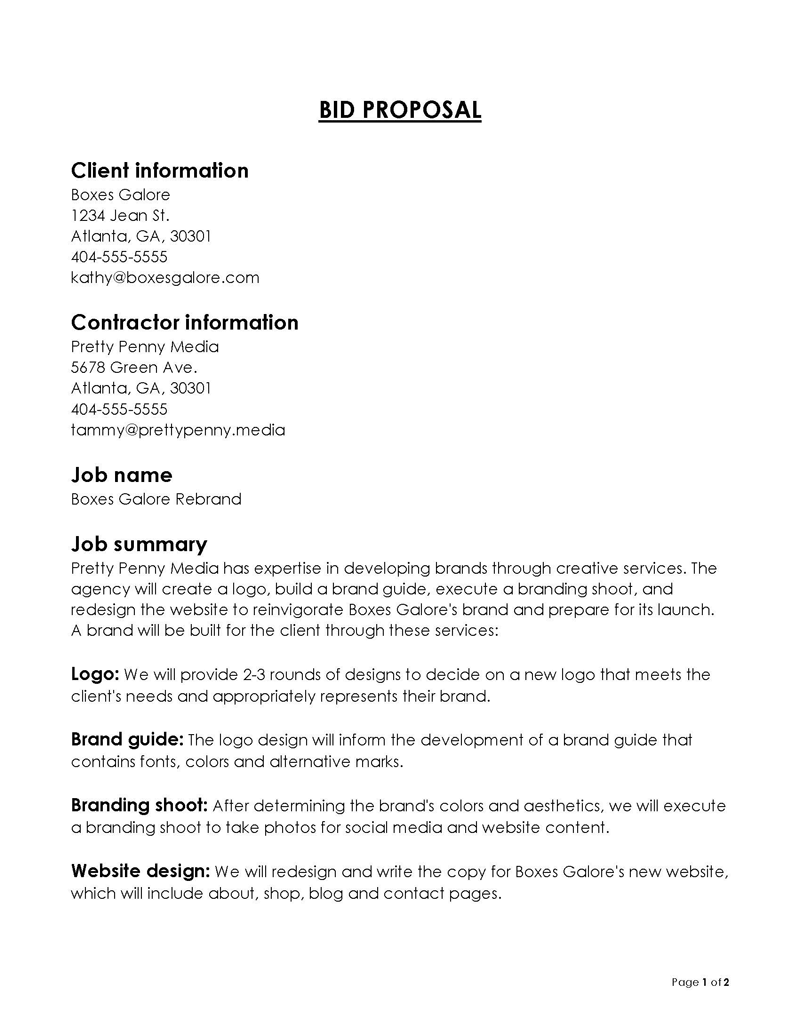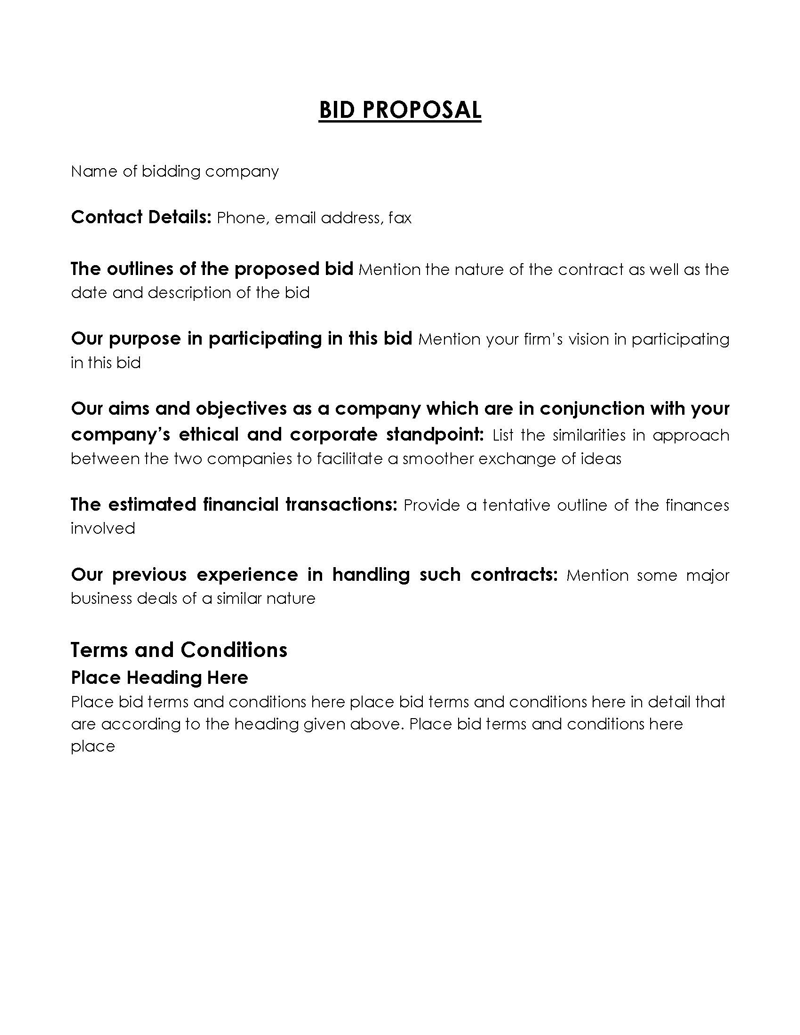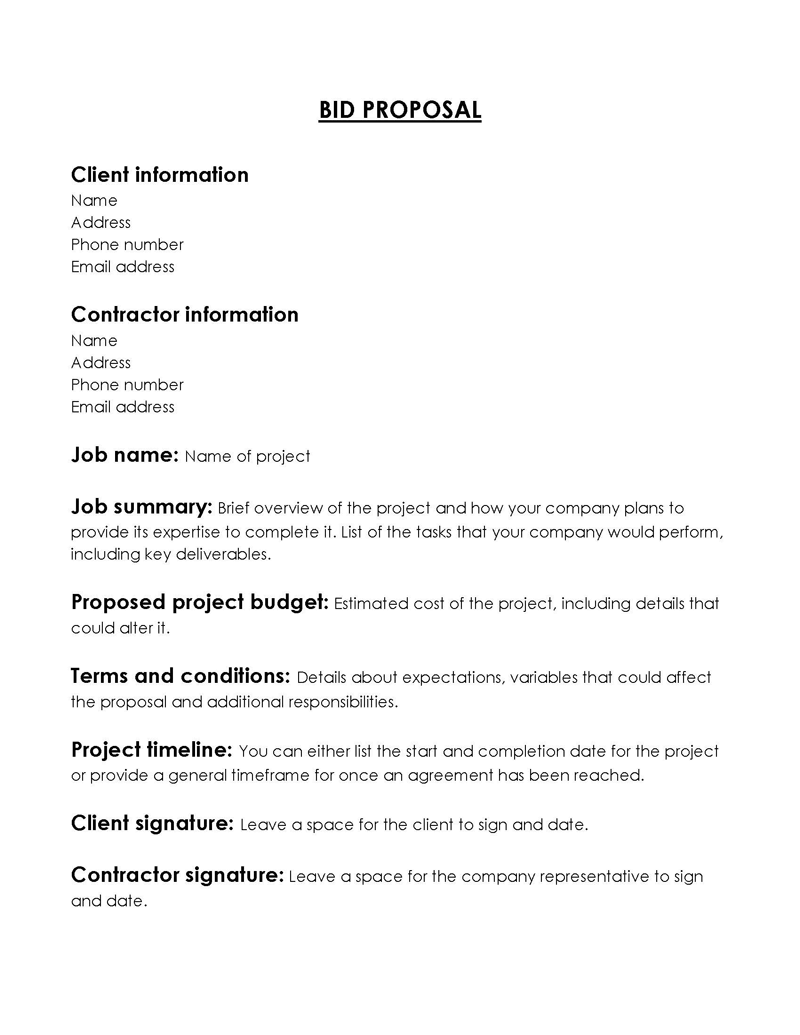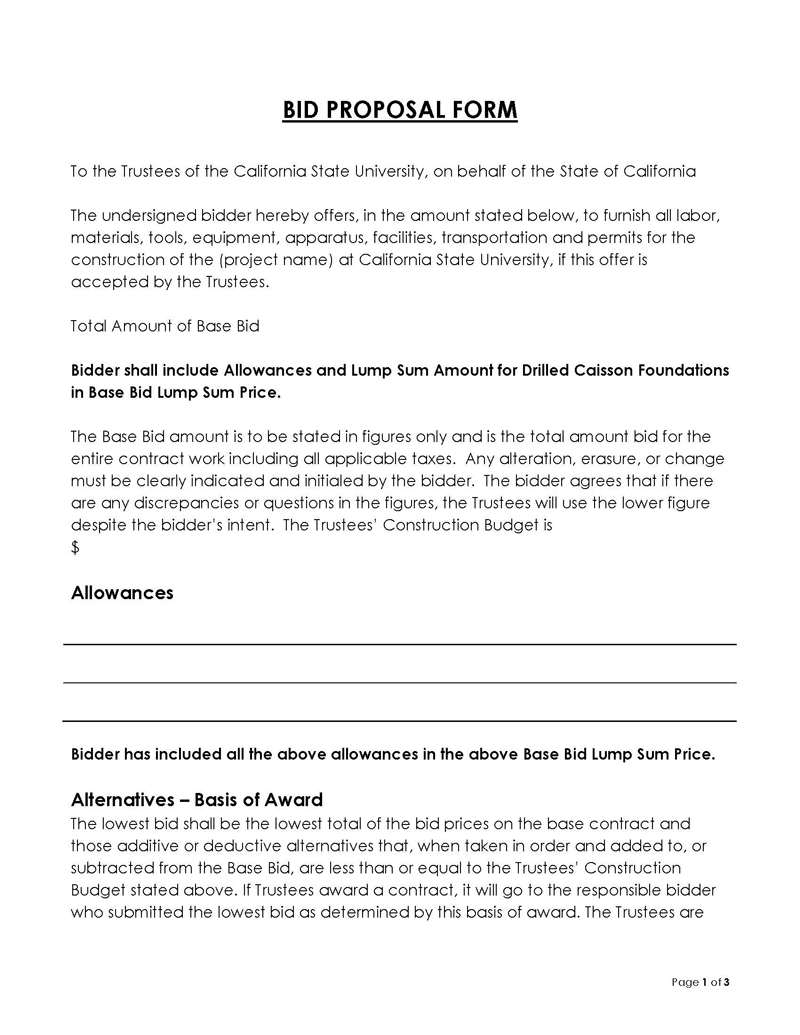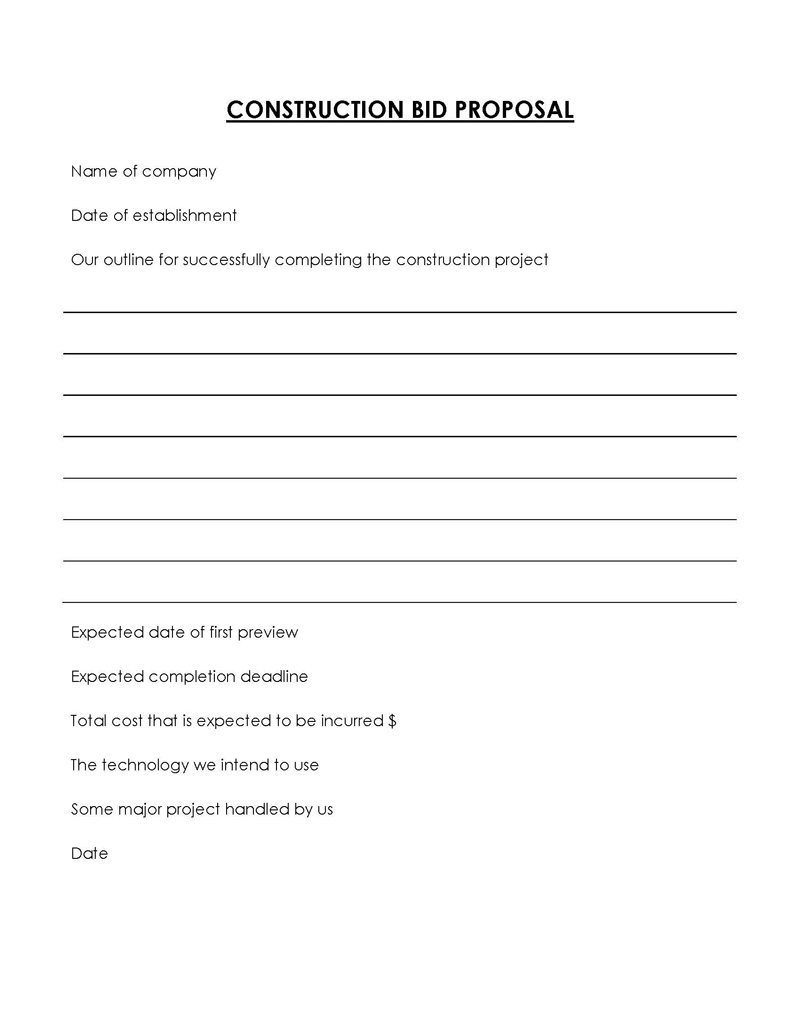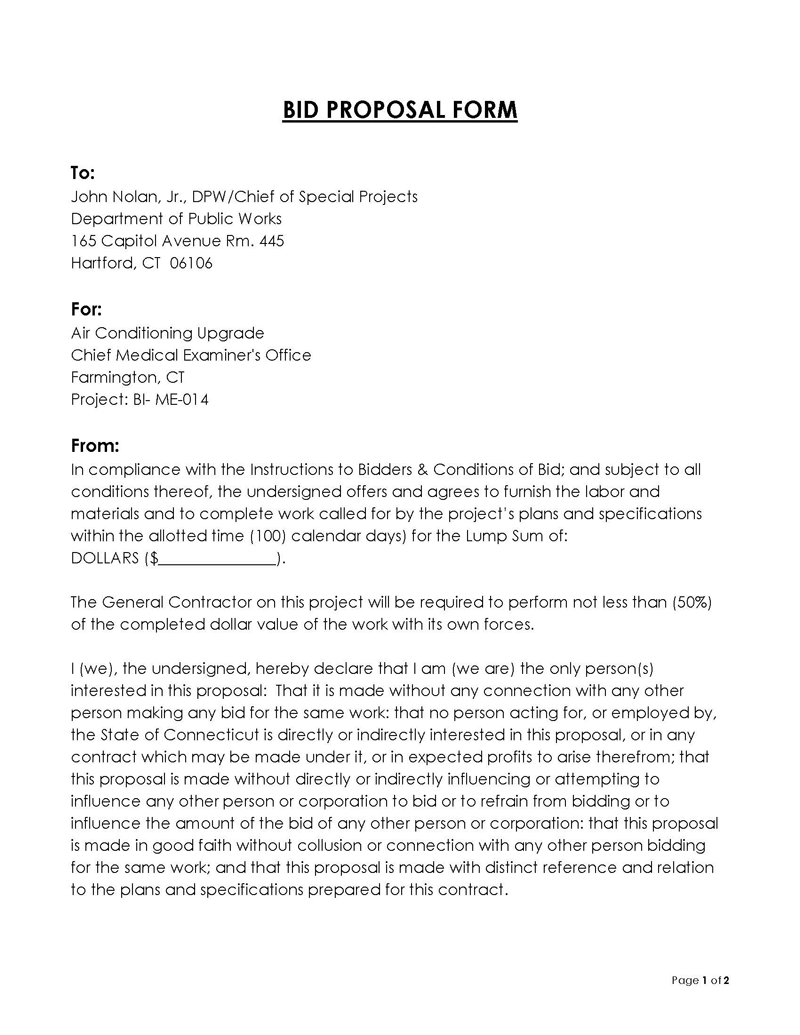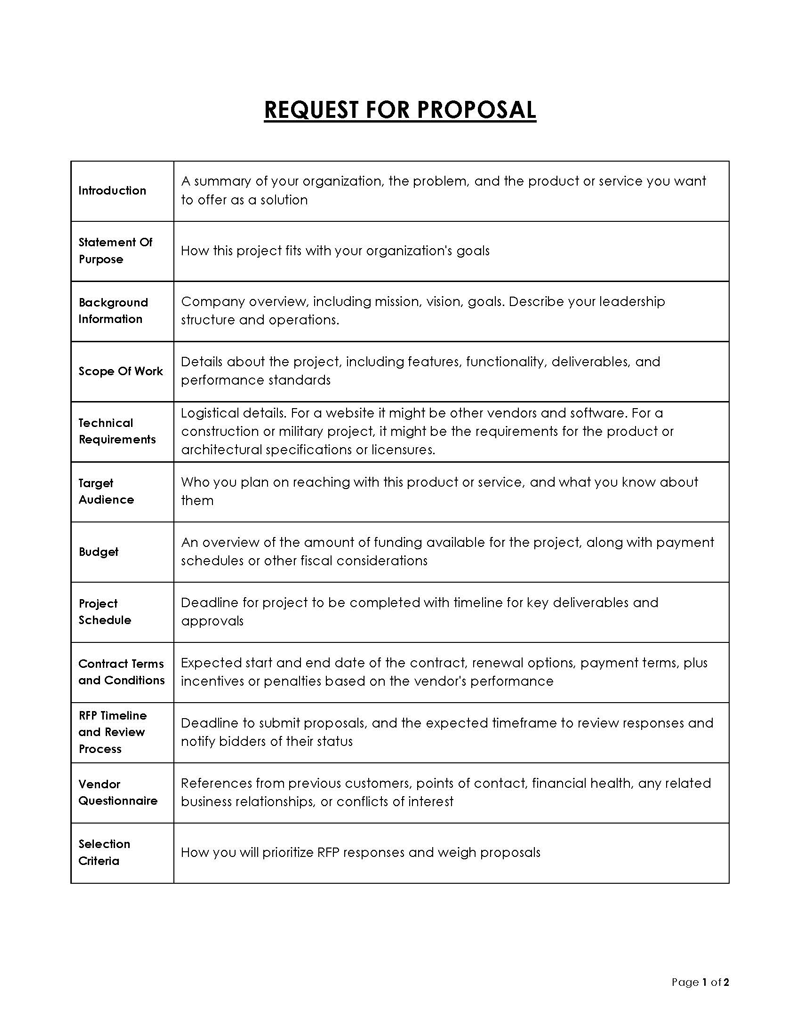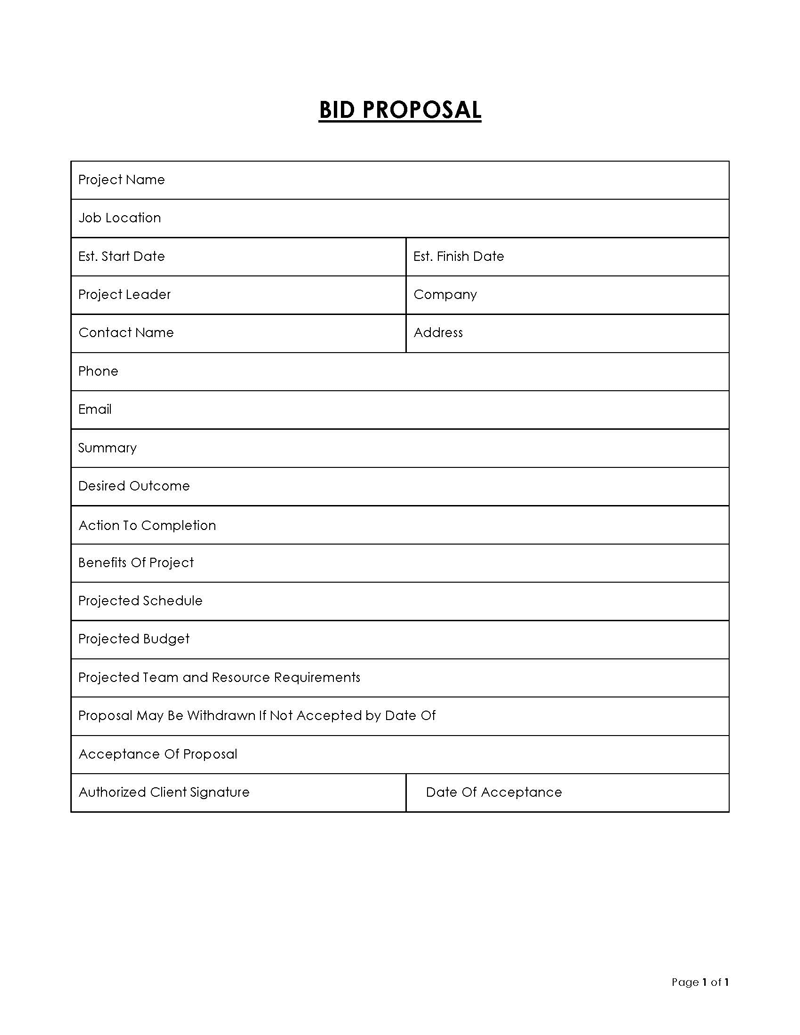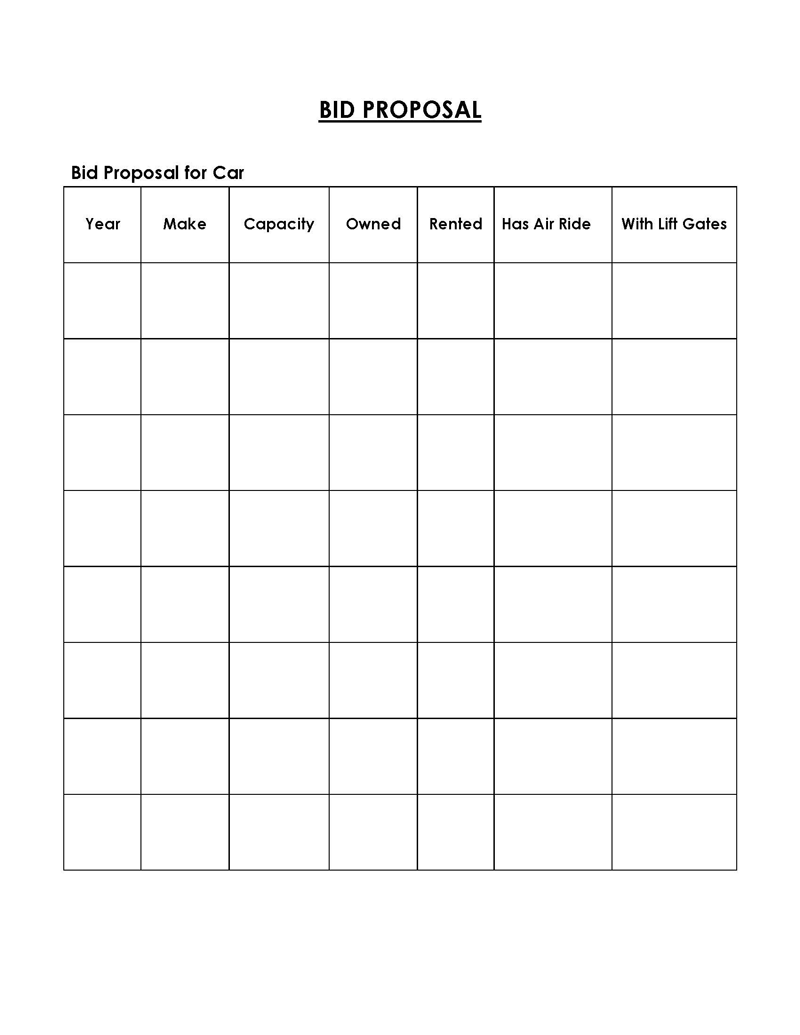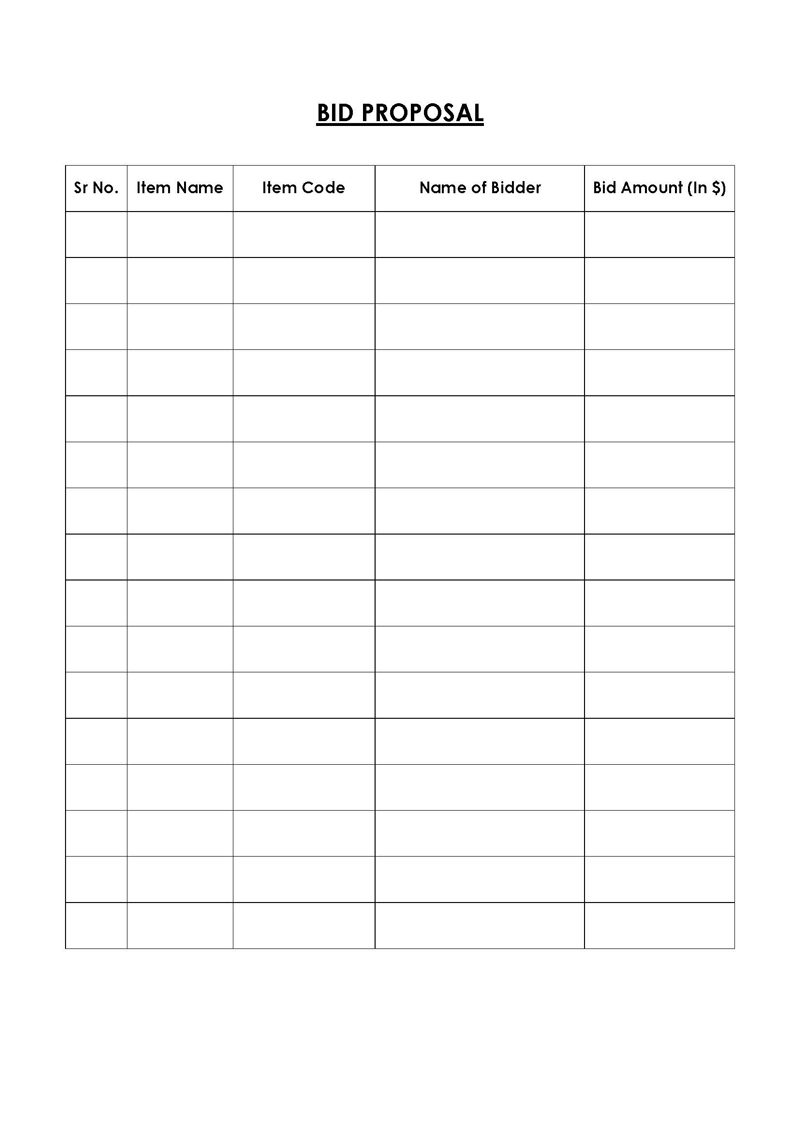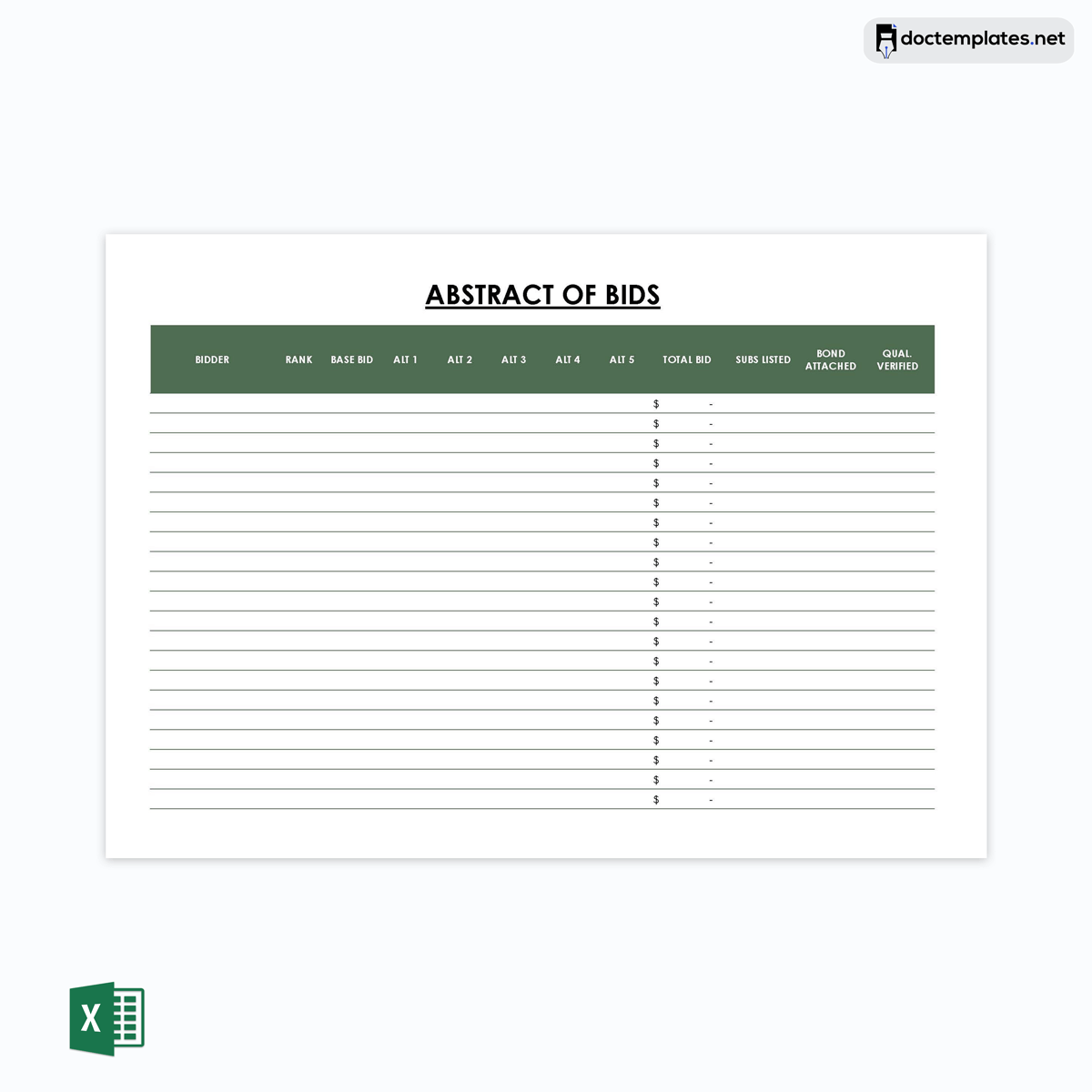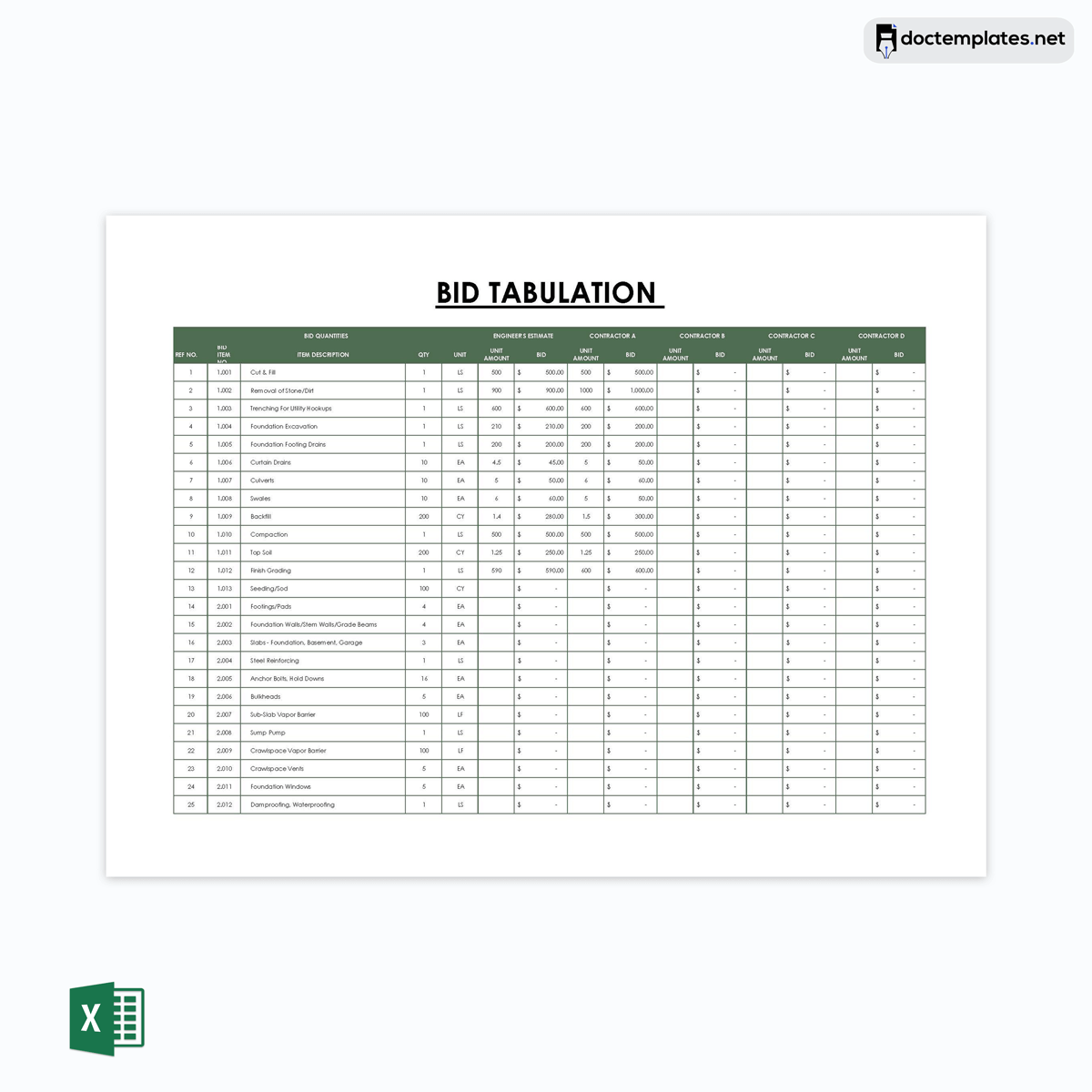An essential aspect of any business that is crucial to the success of freelancers, self-employed individuals, contractors, and other businesses is the writing of bid proposals. Since drafting a proposal for a bid is difficult, you must distinguish yourself from the competition as a bidder by developing an attention-grabbing bid proposal.
Statistically, contracting organizations respond to less than 70% of the bids they receive on an upcoming project, and only one bid lands the job. Therefore, it is imperative to devote sufficient time to researching the contracting organization, the contract being offered, what it entails, and what they anticipate from the project. A well-written proposal may save time and improve client retention. This article will guide you on the elements of a bid proposal and how to write a winning bid.
Bid Proposal Templates
Templates reduce structural deficiencies that might occur when drafting a bid. By keeping your proposal neat, comprehensive, and organized, bid proposal templates enhance the composition of your solutions, increasing your chances of winning the bid.
Each element of a bid proposal must be captured comprehensively, and the elements of your bid have to be well articulated. Since the process of capturing all these elements might be overwhelming, our pre-made downloadable bid proposal templates may make your work easier.
What is a Bid Proposal?
A bid is an offer to fulfill a contract for labor, work, or material supply at a specific price. A bid does not establish rights in the offeror or the offeree unless the offeree accepts the bid willingly. Governments and large or small corporations normally issue and then advertise open contracts for construction, infrastructure, consultancy, and information technology, among others, and companies make bids to win these contracts.
A bid proposal is a written response to a particular offer from a prospective client. It outlines a comprehensive strategy for dealing with the client’s project, including the required resources, the timeframe, output, deadline, and cost, among other particulars. Based on the project’s scope, the proposal may contain a lot or little information.
For example, a freelance writing bid proposal may provide the approximate time needed and overall projected cost. On the other hand, a construction bid proposal may include an exhaustive breakdown of the supplies required to finish the project. The contracting organization undertakes a thorough screening process once proposals are submitted and then awards the contract to the best bidder.
What Clients Look for in a Bid Proposal
To emerge as a top bidder, you must excel on two fronts; draft a captivating bid proposal and deliver quality jobs that exceed the client’s expectations. You can only prove your aptitude in the field after your proposal has been accepted.
Before the contracting organization or client picks a winning bid, they look at these signs in a bid proposal:
- The client’s need is among the most crucial aspects of a bid proposal. The client will want to see that the requirements of their project have been catered for. Other concerns that may arise when the project is undertaken must also be addressed.
- The cost is another important factor in a bid proposal. You have to account for the total amount you are bidding. The client would also like to see if the cost responds to the quality of the work.
- The client will want to see how much experience you have in the field. Statistically, a contractor with more experience but with a more expensive bid is more likely to be picked for a project than a cheaper bidder. The client may also want to see other projects you have worked on and how long you have been on the field.
- To pick a winning bid, the client will see what unique qualities you bring to the table. The bid must make you stand out from others to stand a better chance of being picked.
Considerations Before Writing a Bid Proposal
It is vital to note that the bidding process extends beyond drafting the bid proposal. Having the capacity to complete a project does not necessarily imply that you have the expertise to effectively pursue the project or persuade the client that you are the best option. Multiple tips must be considered before drafting a bid for any project or job.
These considerations include the following:
Understanding the project carefully
Many contractors are so eager to submit a bid proposal for a project that they fail to read and correctly interpret the client’s specifications. Therefore, before presenting the proposal, you should always comprehend the project specifications, what is required to complete it, how long it will take, and what the client desires to accomplish. You may find this by carefully examining and reviewing the project specifications. You can also contact the client for clarification if you are doubtful.
Researching the client
If you know more about the client, it may help you draft an enticing bid proposal while also showcasing why your organization is the ideal choice for the project. It is critical to understand whether the potential client is a good credit risk and whether you should seek payment in advance. A simple google search or browsing the client’s website may suffice. You may also examine the client’s past projects to help you decide whether to take the job or not.
Evaluating the competition
Although this is only occasionally feasible, it is always an excellent idea to examine competitors who are also competing for the same project. A helpful way to do this is by tracking previous bids that competitors made and won and analyzing trends. Most clients will provide a list of all those who downloaded the proposal request. Your experience in the industry may also assist you in identifying likely competitors who may be bidding for the same job. You can analyze competitors by compiling a list, looking at their profiles and projects they have completed, the methods they use, and what they do to make them stand out to help you draft a more competitive bid proposal.
How to Write a Bid Proposal?
When bidding for a job or project, the key concern for you is to know your capabilities and follow all the instructions laid out by the client. You should never be in a rush to draft and submit a bid proposal, as you risk producing a lousy job. At the same time, you should draft the document in as little time as possible, or you risk being overlooked for the job. Some clients may provide a deadline for submitting bid proposals, whereas others may not, but it needs to be done correctly and on time.
The following steps will help you know how to draft a bid proposal:
Write your name and contact information
Provide your name, company name, address, phone number, and email address clearly and articulately in the format shown:
[Name ‘Trading As’ Company Name]
[Address]
[Phone Number]
[Email Address]
Unless you provide your contact information in the bid proposal, the client will be unable to contact you. To be easily reached, make sure that your contact information is up-to-date and always available.
Write the client’s name and contact information
Write the client’s name, email address, or other means of contact made available by the client in the format shown:
[Name ‘Trading As’ Company Name]
[Address]
[Phone Number]
[Email Address]
Include the title of the project
Provide a title that is concise and appealing and that is a one-line summary of the whole bid proposal. The title should create an outstanding first impression while being client-appropriate and compelling.
The following example distinguishes an unpersuasive title and a persuasive one:
Unpersuasive: CCTV Camera Installation Proposal
Persuasive: Ensuring Obstinate Surveillance: Proposal for Complete Installation of A High-Definition Network Surveillance System At Brightburn Academy
If you are undecided about the title, it can always be generated at the end of the drafting process. This may prove to be the best time to title the proposal, as the writing process may inspire an ideal title.
Provide a detailed description of your company
Specify what your organization does or what service it provides. In this part, you are allowed to be creative. Give information about your organization and key project personnel that will be involved in the project. Previous data, case studies, or sample work that give persuasive evidence of past success stories in similar projects might also be included.
Include the services and products provided
Demonstrate your deep comprehension of the client’s issue. It may or may not take the form of a thorough analysis. The specific proposal determines the level of analysis required. Some clients may have already defined their problem, while others may have a Key Performance Indicator (KPI) they wish to meet. The initial aim is to exhibit your understanding of the problem. To feel that your proposed solution will be effective, the client must feel that their concerns are acknowledged.
Provide your solution neatly and specify how effectively it will solve their issue. Your solution should be able to be traced back to the client’s problem. Explain how each aspect or step of your proposed strategy will contribute to the solution.
Define the scope of the solution since it is critical to understand where the solution begins and ends. By clarifying the scope of the solution, you ensure that both you and your client are in agreement, minimizing the risk of future disputes. Outline your offer using concise, jargon-free vocabulary. The writing must be comprehensible and audience-focused regardless of the solution’s complexity.
Write the pricing estimates
Once you have determined what the project entails and identified all expenses, provide a proper pricing estimate. If the client specifies a budget, ensure your bid falls within it; if there is no budget, keep your bid modest. Adhere to competitive rates and ensure it is sufficient to do an excellent job. Avoid being too cheap; it may prevent the most serious clients. The pricing estimate should be precise, attractive, and simple to comprehend. You may also include a contingency budget of around 10% of the entire cost to cater to any eventualities.
Mention any terms and conditions
Outline the terms and conditions of your bid concisely. Some clients may want to discuss terms after selection. Find out the requirements of the client and draft terms and conditions accordingly. These terms and conditions should not be too strict that they may discourage the client, nor should they be too lenient that you may be taken advantage of. Seek legal advice before writing the terms and conditions.
Provide an estimated timeline
Provide an estimate of how much time it will take to complete the project. A detailed timeline will explicitly define the extent and execution of the project. The timeline may be precise and exact depending on the client’s requirements. It might also be flexible or contingent on the offer acceptance date, depending on your expectations. A timeline should be assigned to completing each task. Make a point of identifying and addressing any potential flaws in the timeline. This will show the client that you value the project and are serious about completing it.
Add thoughtful graphics
You may include well-designed, useful, and colorful graphics in your proposal. These may include pie charts, graphs, and pictures of previous successful projects. Graphics make it easier for the client to understand the bid proposal better.
Include your signature as well as of client’s
Include your name, signature, and date, as well as that of the client, in the format below:
Bidder Client
Name: _____________ Name: _____________
Sign: _____________ Sign: _____________
Date: _____________ Date: _____________
Signatures indicate that both you and your client have read, acknowledged, and agreed to the terms and conditions provided in the bid proposal. This may be done in the presence of witnesses or a public notary to aid in the legal execution of the terms and conditions.
Useful Tip: It is advisable to have your bid proposal as a PDF document that you can email directly to the contracting organization. This helps you avoid the slow postal process, and the client may respond to your bid faster. However, before sending your document, ensure you have signed it. This gives the client faith in your abilities as it shows you understand the needs of the job. You may use Foxit Reader or Adobe Sign to sign your document electronically.
Do’s And Don’ts When Writing A Bid Proposal
After drafting your bid proposal, you should take your time to submit it. Clients see and assess your ability to complete the task via your proposal. Therefore, you should note the following tips before submitting your bid:
Do’s
Before drafting a single word, each bid proposal must be thoroughly planned. Here are some things you are encouraged to do when bidding for a contract:
- Bid on suitable projects: Evaluate your odds of being the winning bidder. Assess the working environment and the site. You should also assess the job’s difficulty. Some projects are not worth the time required to prepare a bid. If the project is simple and easy enough, you will likely be able to generate a profit.
- Have a tailored response: Present a bid proposal that solves the client’s problem. Your solution should be unique, concise, and well-outlined. The more unique the solution, the better the chances of being picked as the winning bidder.
- Provide contract examples: If a previous client was satisfied with your work, ask them to contact the decision-maker on your current bid proposal. Most clients will request around three examples of contracts you completed in the previous five years. These contract examples should be included in your proposal, especially if they are for similar projects.
- Write persuasively to influence: Your bid proposal is intended to sell your organization; therefore, it should be attractive. Be sure to use powerful and compelling language while presenting your concept. The content should be written in such a manner that it elevates your solution above the competition. Positive language or phrases will increase the proposal’s allure. Clients expect excellent outcomes and successful projects. The wording must be convincing and uplifting, but it must also be practical. Only accurate information that can be conveyed fully should be provided.
- Do proofread: A comprehensive review is essential to the bid’s success. Proposals must be audience-based, competitive, truthful, convincing, informative, and well-formatted, among other things. A review identifies faults or errors that might lead to the bid being lost or costly future disputes if the bid is won.
Don’ts
Writing for the client and delivering a concise, valuable solution to their problem is what it takes to draft a winning proposal. Failure to adhere to this protocol may result in losing out on the bid.
The following are some of the things you are discouraged from doing when bidding:
- Avoid scripted bid proposals: Several written bid samples are available on the internet; they should not be copied literally but used as a reference. Clients can easily tell when your bid proposal is excessively generic. It might convey the message that your organization is unprofessional.
- Avoid being too hasty: Take your time drafting and submitting a bid proposal. It may seem tedious to take your time, but this helps capture the project’s scope. It may also show the client that you understand the project’s requirements properly.
- Don’t be impersonal: Refrain from praising your organization and listing all your achievements. Highlight just a few achievements to maintain your chances. The whole point of a bid proposal is solving the client’s problem.
- Do not underbid your competitors: Do not underbid your competitors, as this has long-lasting detriments to your organization. Underbidding may hurt your bottom line, damage your organization’s status and limit future projects. It also runs the long-term risk of shrinking the entire industry since your competitors will also be encouraged to do the same.
- Avoid taking rejection personally: Do not take bid rejection personally. Keep a record of prior bids that were won and look for patterns. Determine to whom you are losing and why. This may improve your bidding technique and help you write better proposals.
Conclusion
A bid proposal must be submitted to the client once the drafting and review are concluded. It may appear simple, but you should not take it lightly. Most clients have a preferred or stipulated submission procedure. The client might ask you to upload the document or mail a hard copy to their offices. If a perfect proposal is submitted improperly, it may lose the contract.
A winning bid proposal allows you to demonstrate your organization’s capabilities and unique approach to meeting a client’s objectives. It is worth noting that drafting a solid bid proposal is a complex endeavor. However, when done correctly, it may be the key to business success.
